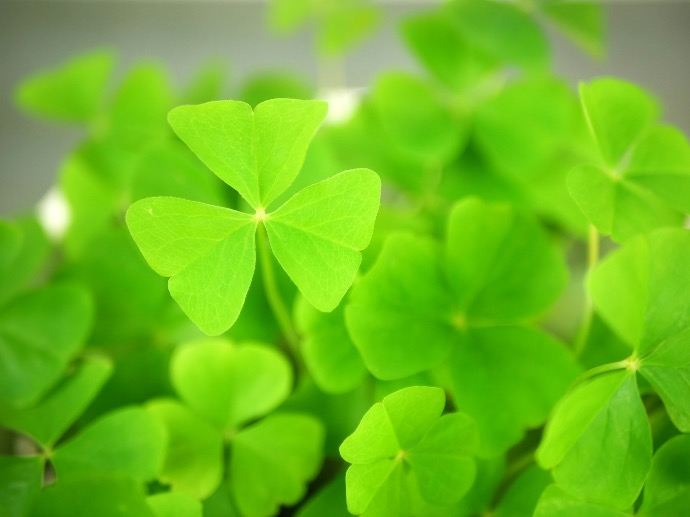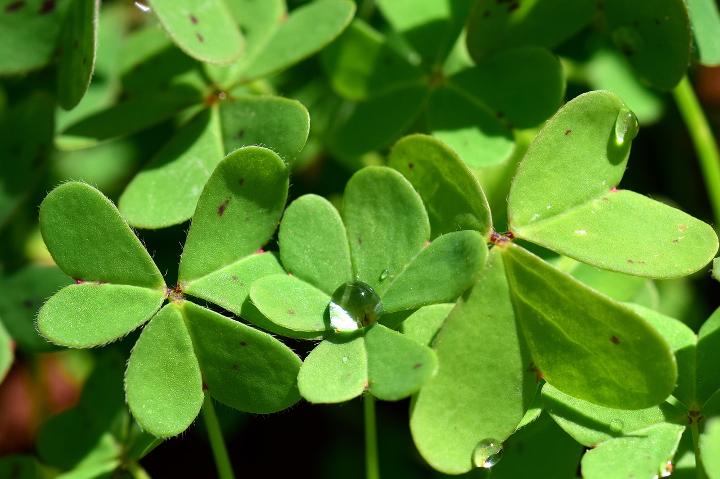Oxalis Plant
Oxalis, also known as Shamrock or Wood Sorrel, is an outdoor plant with clover-like leaves. Plant in well-draining soil with partial to full shade. Water consistently and divide clumps to rejuvenate the plant. Pruning helps control its size and shape.

Habit
Perennial
Height
0.2-0.4 m
Growth
Fast
Soil
Well-drained, loamy
Shade
Full Sun to partial shade
Moisture
Moist
Edible
No
Medicinal
No
Origin
Worldwide
Climatic Condition
Temperate, Tropical
Temperature (°)
15-30°C
Humidity (%)
60-80%
Potting media
Loamy, peat
Fertilizers
Balanced NPK (10-10-10)
Watering
Moderate, infrequent
Plant Weight
50-150 g
Flowering Time
Spring, Summer
Soil Ph level
6.0 - 7.0
Water Ph level
6.0 - 7.0
Soil EC
1-2 dS/m
Yield Per Plant
Ornamental
NPK ratio
10:10:10
life Span
Perennial
Health Benefits
Used for decorative purposes, mood boosting
Common Diseases and Remedies
Rust
Infected tissues eventually become completely necrotic, Includes chlorotic spots on the leaf.
Neem Oil .
HEALTH BENEFITS
· Contains vitamin C and has mild antibacterial properties.
· Used traditionally for treating scurvy and digestive issues.
· Has diuretic effects, aiding in kidney health.
⚠️ Caution: Contains oxalic acid, which can be toxic in large amounts.
What Is An Oxalis?
Oxalis is a genus of flowering plants in the Oxalis family (Oxalis family). Known for its distinctive trifoliate leaves, many have five-petaled flowers. Some species are grown as ornamentals, while others are considered invasive weeds. Oxalis species are found in a variety of habitats around the world, including tropical and temperate regions. Oxalis is a genus of flowering plants in the Oxalis family (Oxalis family). It is known for its distinctive three-lobed leaves, often producing flowers with five petals. Some species are grown as ornamentals, while others are considered invasive weeds. Oxalis species are found in a variety of habitats around the world, including tropical and temperate regions.

What Are The Different Types Of Oxalis?
1. Oxalis triangularis (Purple Shamrock or False Shamrock)
Known for its distinctive purple leaves and triangular shaped leaves.
2. Oxalis pes-caprae (Bermuda buttercup or sourgrass)
Known for its yellow flowers and clover-like leaves, it is often considered an invasive species in some areas.
3. Oxalis acetosella (Oxalis or Oxalis)
A plant native to many parts of Europe and North America with clover-like leaves and white or pink flowers.
4. Oxalis regnellii (Lucky Clover or Shamrock Plant)
Cultivated for its attractive foliage in various shades of green, purple, or silver.
5. Oxalis corniculata (creeping sorrel or lying sorrel)
A low-growing species with yellow flowers and heart-shaped leaves, often considered a lawn weed.

How To Care For Oxalis?
1. Location
Oxalis plants are versatile and can be grown indoors or outdoors. It grows in well-drained soil and, depending on the species, prefers partial shade to full sun. Whether you're planting them indoors in containers or outdoors in garden beds, ensure the soil is consistently moist but not waterlogged. If you're in a colder climate, you may need to bring potted oxalis indoors during the winter months to protect them from frost.
2. Sunshine
Oxalis plants generally prefer bright, indirect sunlight. They can tolerate some direct sunlight, especially in the morning, but too much direct sun can cause their leaves to burn. Aim for a location with filtered sunlight or a spot where they receive morning sun and afternoon shade. Always monitor whether your plants are receiving the right amount of light and adjust their placement accordingly.
3. Soil
Oxalis plants generally prefer well-drained soils that are rich in organic matter. It is effective to mix equal amounts of potting soil, perlite or drainage sand, and compost. Make sure the soil pH is slightly acidic to neutral. Avoid heavy clay soils with high moisture content as this can cause root rot in Oxalis.
4. Hydration
Hydration of Oxalis, commonly known as Oxalis, requires providing even moisture without overwatering. Water the plant when the top of the soil feels dry and make sure the soil is evenly moist but not soggy. Oxalis prefers constantly moist conditions, so avoid allowing the soil to completely dry out between waterings. However, it is important to drain excess water to prevent root rot. Adjust the frequency of watering depending on environmental conditions such as temperature and humidity.

5. Nourishment
Oxalis, commonly known as sorrel or shamrock, is an easy-care plant that does not require much fertilization. However, if you want to supplement nutrients, you can use a balanced water-soluble fertilizer diluted to half strength. Apply every 4 to 6 weeks during the growing season (spring and summer). Water thoroughly after applying fertilizer to prevent root burn.
6. Issues
Oxalis has root blight, tuber blight, spot blight, botrytis blight, powdery mildew, and southern blight. Click here for more information on these issues. The best way to check for pests is to look at the underside of the leaves. This is where most infestations occur.
What Are The Benefits Of Mustard Greens
Edible Many species of Oxalis are edible and have a spicy taste due to oxalic acid . It can be used in salads, soups, or as a side dish. Medicinal Uses Some cultures use Oxalis for its medicinal properties, including the treatment of urinary tract infections, fever, and digestive disorders. However, it is important to consult your doctor before using it for medical purposes. Ornamental Plant Oxalis is often grown as an ornamental plant for its attractive foliage and delicate flowers, adding beauty to gardens and indoor spaces. Nitrogen fixation Some species of Oxalis have the ability to fix nitrogen in the soil, which improves soil fertility and benefits surrounding plants.

FAQs About Growing Oxalis
1. Can I grow oxalis plant indoor?
Yes, you can grow oxalis plants indoors. They are well-suited for indoor environments as long as they receive adequate light and are provided with the right growing conditions such as well-draining soil and regular watering. They also prefer indirect sunlight, making them ideal for indoor settings.
2. Which pot is best for growing oxalis plant?
Oxalis plants, also known as Moses-in-the-cradle or Tradescantia spathacea, thrive in well-draining pots with a rich, moist potting mix. Consider using a ceramic or terracotta pot with drainage holes to prevent waterlogging. The pot size should accommodate the plant's root system, allowing for some room to grow but not too much excess space, as this can lead to overwatering issues.
3. From where can I shop for oxalis plant?
You can shop for oxalis plants at local nurseries, garden centers, or online plant retailers. Websites like Etsy, Amazon, and specialized plant shops often have a variety of oxalis plants available for purchase. Additionally, you may find them at farmers' markets or botanical gardens if they have plant sales.
4. How to maintain oxalis?
Light and Temperature: Oxalis plants prefer bright, indirect light and moderate temperatures between 60-75°F (15-24°C). Avoid direct sunlight, as it can scorch the leaves. Watering Water the oxalis when the top inch of soil feels dry to the touch. Ensure proper drainage to prevent root rot. During dormancy, reduce watering but don't let the soil completely dry out. Soil Plant oxalis in well-draining potting soil. A mix of peat moss, perlite, and sand works well. Repot annually or when the plant outgrows its container. Fertilizing Feed oxalis with a balanced liquid fertilizer diluted to half strength every 4-6 weeks during the growing season (spring and summer). Dormancy Oxalis goes dormant in the fall and winter. During this time, reduce watering and withhold fertilizer. Some species may lose their leaves entirely. Store dormant bulbs in a cool, dry place. Pests and Diseases Watch for pests like aphids, spider mites, and mealybugs. Treat infestations promptly with insecticidal soap or neem oil. Ensure good air circulation to prevent fungal diseases. Propagation Oxalis can be propagated by division or from bulb offsets. Divide overcrowded clumps in spring or early summer, or separate offsets from the parent bulb and plant them in individual pots. Pruning Trim back leggy or dead foliage as needed to maintain the plant's appearance and encourage new growth. By following these guidelines, you can keep your oxalis healthy and thriving.
5. What are the uses of oxalis?
Oxalis, commonly known as wood sorrel or shamrock, has various uses Culinary Some species of Oxalis have edible leaves, flowers, and stems. They add a tangy flavor to salads, soups, and sauces. Medicinal Traditional medicine uses Oxalis for treating ailments like urinary tract infections, fever, and scurvy due to its high vitamin C content. Ornamental Many cultivars of Oxalis are grown as ornamental plants for their attractive foliage and flowers. They are popular in gardens and as houseplants. Natural dye Some varieties of Oxalis produce dyes for coloring fabrics and other materials. Erosion control Certain species of Oxalis are used in erosion control due to their spreading habit and dense root systems, which help stabilize soil. Insect repellent Some varieties of Oxalis are believed to repel insects due to their natural compounds. However, it's important to note that not all species of Oxalis are suitable for consumption, and some may even be toxic. Therefore, it's crucial to properly identify the species before using them for any purpose.